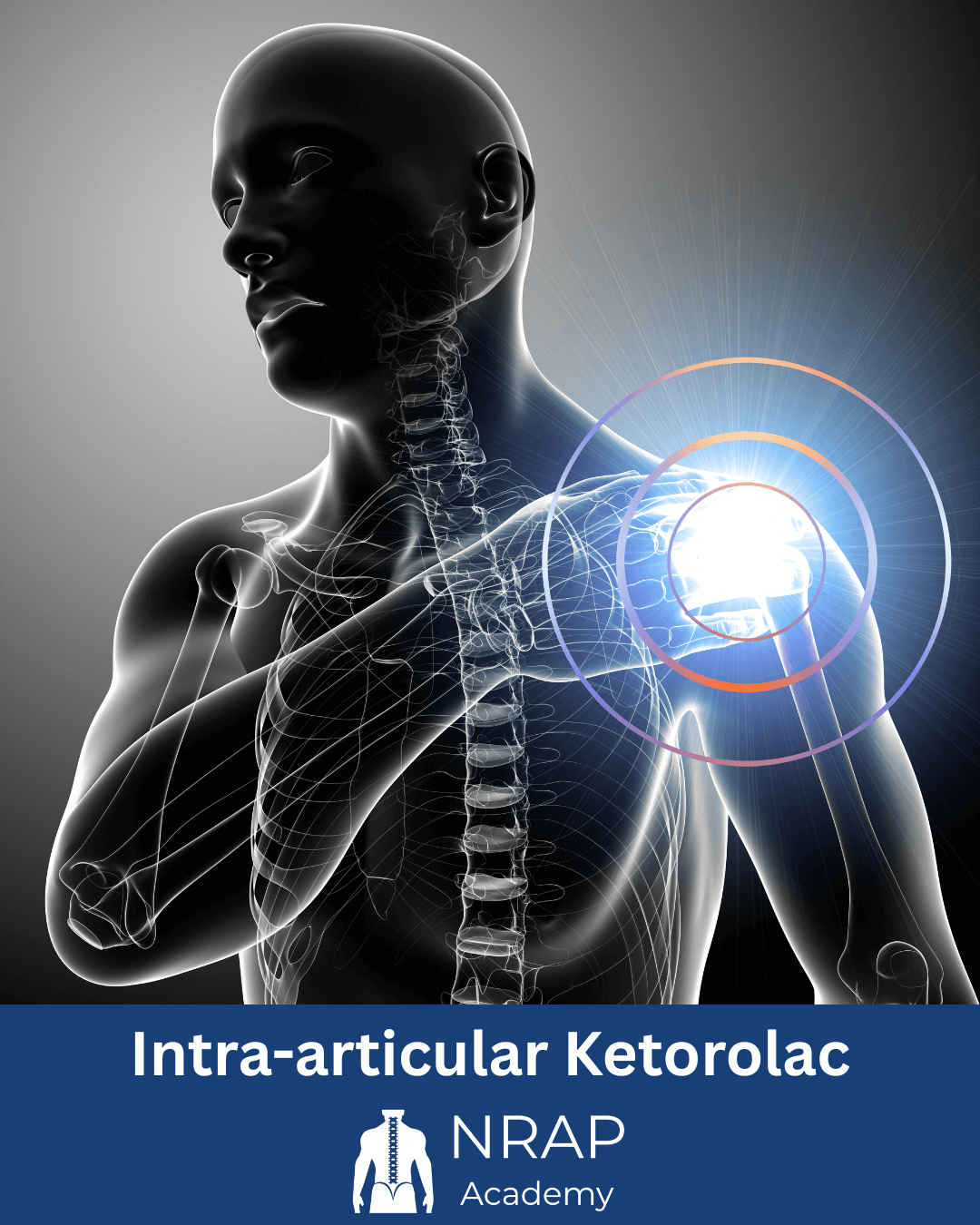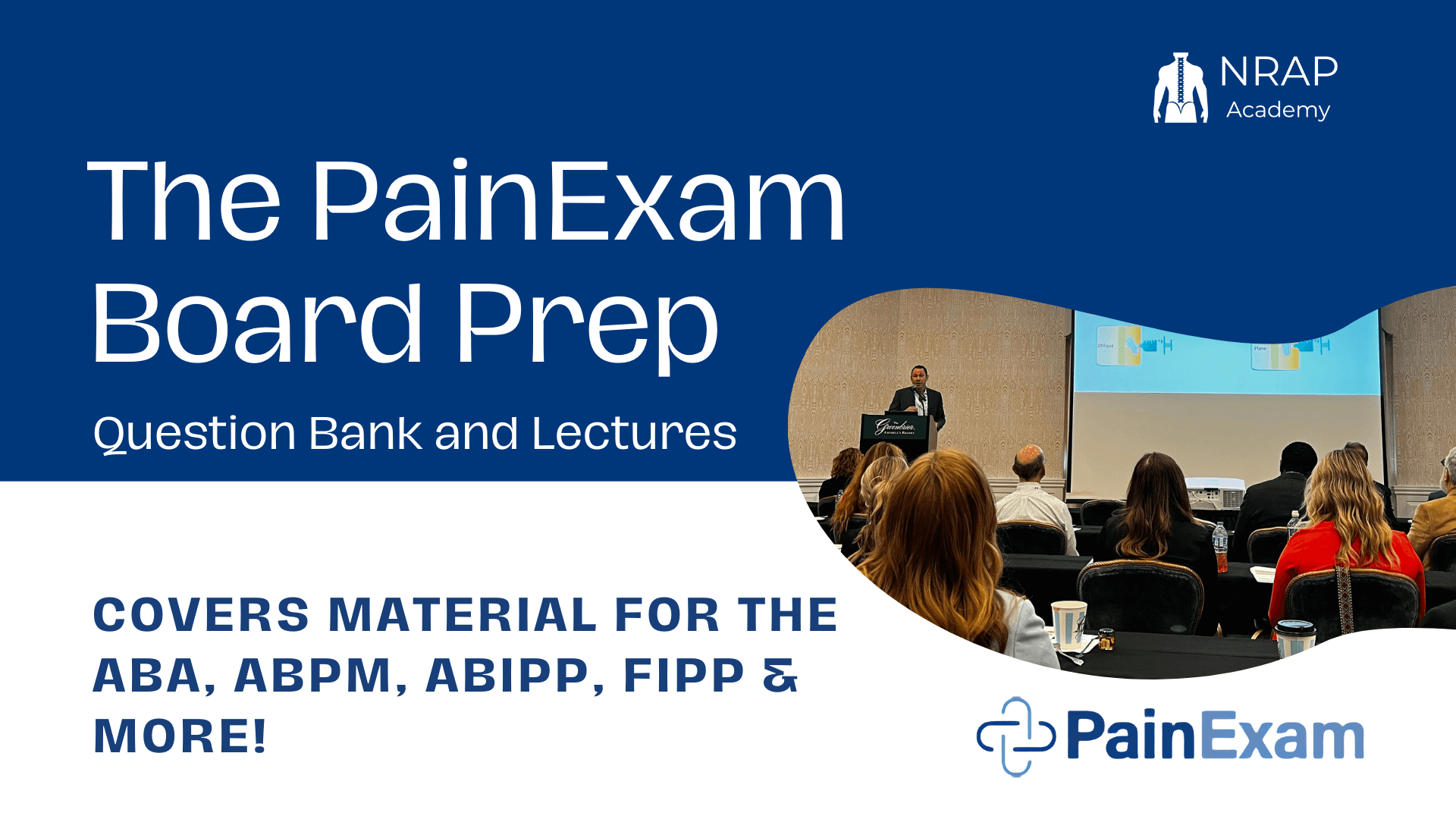Intra-articular Ketorolac vs Steroid for Pain: Journal Club
Release Date: 08/06/2025
 What is Kratom? Effects, Side Effects and Benefits in Pain Reduction
What is Kratom? Effects, Side Effects and Benefits in Pain Reduction
AnesthesiaExam Podcast
🎙️ PainExam Podcast Show Notes Kratom (Mitragyna speciosa): What Pain Physicians Must Know for the Boards In this episode, Dr. David Rosenblum reviews the current science, pharmacology, risks, and clinical relevance of Kratom — an herbal substance widely discussed by pain patients and increasingly appearing on pain-medicine board exams. The discussion focuses on evidence-based mechanisms, safety considerations, and counseling points essential for ABA/ABPM/ABIPP/FIPP board preparation. 🔍 Key Board-Relevant Takeaways 1. Pharmacology & Mechanism Kratom’s primary alkaloids are...
info_outline Caudal Epidural Steroid Injeciton with PRP
Caudal Epidural Steroid Injeciton with PRP
AnesthesiaExam Podcast
Caudal Epidural Steroid Injection with PRP Case Reports and a Testimonial! Upcoming Training Courses and Services and : New York and Detroit locations scheduled Private Coaching Services: Ultrasound guidance Preceptorship Board preparation coaching Contact available via email for interested physicians PRP Caudal Epidural Research Review Study Overview: Randomized double-blind controlled pilot study comparing leukocyte-rich PRP versus corticosteroids in caudal epidural space 50 patients randomly assigned to two groups Treatment options: triamcinolone 60mg or...
info_outline Supplements for Pain: Does the Evidence Support it?
Supplements for Pain: Does the Evidence Support it?
AnesthesiaExam Podcast
Episode Overview In this episode, Dr. David Rosenblum discusses the role of supplements and complementary strategies in the management of chronic pain. Drawing from clinical practice at AABP Integrative Pain Care, as well as his teaching and training programs, Dr. Rosenblum reviews how nutraceuticals, regenerative therapies, ultrasound-guided procedures, and neuromodulation can work together to improve patient outcomes and reduce opioid reliance. This episode also highlights educational opportunities and exam-prep resources for pain fellows, residents, anesthesiologists, physiatrists, and APPs...
info_outline BMAC and PRP for ACL Tears- Journal Club
BMAC and PRP for ACL Tears- Journal Club
AnesthesiaExam Podcast
Pain Exam Podcast Recent Conference Activities London Conference Weekend: Successfully attended and spoke at ISPN and SOMOS care conferences Somos Care Conference: Delivered presentation on pain management for primary care physicians Presentation consisted of 50+ slides with only one slide dedicated to opiates Emphasized shift away from opiate-based treatments in interventional pain management Recommended primary care physicians refer patients to pain specialists for comprehensive treatment options ISPN Conference: Participated in international pain management conference Met with...
info_outline Chronic Pain and the TENS Unit
Chronic Pain and the TENS Unit
AnesthesiaExam Podcast
Project Sync / Status Update Summary Podcast Episode Overview The host discussed Transcutaneous Electrical Nerve Stimulation (TENS) as a recurring pain board topic and reviewed mechanisms, efficacy, and clinical considerations. Emphasis that TENS appears on pain boards annually and is a foundational topic from early podcast episodes. Board Prep and NRAP Community at or ABA ABPM ABIPP FIPP Pain Management Board prep, Question Banks, and Virtual Pain Fellowship Educational Offerings and Events Training and Courses: Monthly ultrasound courses in New York and upcoming courses in Detroit...
info_outline Exploring the Efficacy of BMAC and ADSC Injections in Knee Osteoarthritis
Exploring the Efficacy of BMAC and ADSC Injections in Knee Osteoarthritis
AnesthesiaExam Podcast
Exploring the Efficacy of BMAC and ADSC Injections in Knee Osteoarthritis Hosts: David Rosenblum,MD Overview: In this episode, we delve into a recent study published in the Indian Journal of Orthopaedics that compares the therapeutic efficacy of Bone Marrow Aspirate Concentrate (BMAC) and Adipose-Derived Stem Cells (ADSCs) for treating knee osteoarthritis (OA). The study aims to provide insights into the effectiveness of these regenerative treatments and their correlation with mesenchymal stem cell (MSC) cellularity. Key Points Discussed: Background on Osteoarthritis:...
info_outline Intra-articular Ketorolac vs Steroid for Pain: Journal Club
Intra-articular Ketorolac vs Steroid for Pain: Journal Club
AnesthesiaExam Podcast
Podcast Summary This episode of the Pain Exam Podcast, hosted by Dr. David Rosenblum, discusses an interesting article about Ketorolac injections for musculoskeletal conditions. The podcast covers: Ketorolac is an NSAID that provides analgesic and anti-inflammatory effects through inhibition of prostaglandin synthesis Multiple studies comparing Ketorolac injections to corticosteroids and hyaluronic acid for various conditions Research shows Ketorolac injections are equally effective as corticosteroids for subacromial conditions, adhesive capsulitis, carpal-metacarpal joint issues, and...
info_outline Post Herpetic Neuralgias: Epidurals, Paravertebral Blocks and more!
Post Herpetic Neuralgias: Epidurals, Paravertebral Blocks and more!
AnesthesiaExam Podcast
Summary In this episode of the Pain Exam Podcast, Dr. David Rosenblum provides a comprehensive review of herpes zoster and postherpetic neuralgia (PHN), focusing on pathophysiology, diagnosis, and treatment options. Dr. Rosenblum explains that postherpetic neuralgia affects approximately 25% of patients with acute herpes zoster, causing debilitating unilateral chronic pain in one or more dermatomes. He discusses the three phases of herpes zoster: acute (up to 30 days), subacute (up to 3 months), and postherpetic neuralgia (pain continuing beyond 3 months). Dr. Rosenblum identifies risk factors...
info_outline The Neurolytic Celiac Plexus Block for the Anesthesia Boards!
The Neurolytic Celiac Plexus Block for the Anesthesia Boards!
AnesthesiaExam Podcast
Summary In this Pain Exam Podcast episode, Dr. David Rosenblum discusses a journal club article on low volume neurolytic retrocrural celiac plexus blocks for visceral cancer pain. The study reviewed 507 patients with severe malignancy-related abdominal pain, with data retained for 455 patients at the 5-month mark. Dr. Rosenblum explains that the procedure involves injecting 3-5ml of 6% aqueous phenol at the T12-L1 level under fluoroscopic guidance, with an average procedure time of 16.3 minutes. The study found significant pain relief lasting up to six months, reduced opioid...
info_outline Epidural PRP Injections...What's the deal?
Epidural PRP Injections...What's the deal?
AnesthesiaExam Podcast
PRP in the Epidural Space for Radiculopathy Brooklyn Based Pain Physician, David Rosenblum, MD known for his work publishing and teaching Regenerative Pain Medicine and Ultrasound Guided Pain Procedures hosts this podcast covering the latest and most advanced concepts in Pain Medicine. Summary Dr. David Rosenblum delivered a comprehensive lecture covering several key topics in pain management. He discussed his upcoming speaking engagements at PainWeek, ASPN and great upcoming meetings like the Latin American Pain Society, and other conferences. Dr. Rosenblum shared his extensive experience...
info_outlinePodcast Summary
This episode of the Pain Exam Podcast, hosted by Dr. David Rosenblum, discusses an interesting article about Ketorolac injections for musculoskeletal conditions. The podcast covers:
- Ketorolac is an NSAID that provides analgesic and anti-inflammatory effects through inhibition of prostaglandin synthesis
- Multiple studies comparing Ketorolac injections to corticosteroids and hyaluronic acid for various conditions
- Research shows Ketorolac injections are equally effective as corticosteroids for subacromial conditions, adhesive capsulitis, carpal-metacarpal joint issues, and hip/knee osteoarthritis
- Ketorolac may be a safer alternative to steroids for certain patients, though it has its own contraindications for those with renal, gastrointestinal, or cardiovascular disease
- Dr. Rosenblum considers the potential of using Ketorolac injections directly at pain sites rather than intramuscularly
Upcoming Courses and Conferences
- Ultrasound courses in New York and Costa Rica (check unwrappedpain.org)
- Private ultrasound sessions available
- Dr. Rosenblum will be speaking at Pain Week about ultrasound in pain practice and PRP
- Presenting at a primary care conference in London
- Teaching ultrasound at ISPN
- LAPS conference in Chile (Dr. Rosenblum won't attend this year)
-
Ketorolac Injections: An Effective Alternative for Musculoskeletal Pain Management
Musculoskeletal conditions such as bursitis, adhesive capsulitis, and osteoarthritis affect millions and often require injectable therapies to reduce pain and inflammation. Traditionally, corticosteroid injections have been the mainstay treatment. However, concerns over side effects like tendon rupture, cartilage damage, and systemic hyperglycemia have prompted exploration of alternatives. A recent narrative review by Kiel et al. (2024) highlights ketorolac—a parenteral nonsteroidal anti-inflammatory drug (NSAID)—as a promising substitute for corticosteroids in musculoskeletal injections.
Warning: OFF Label use of Ketorolac discussed. Please consult your physician.
See full article for details.
 Subacromial Ketorolac Injections for Shoulder Pain
Subacromial Ketorolac Injections for Shoulder PainSubacromial bursitis and impingement syndrome are common causes of shoulder pain and disability. Several randomized controlled trials have shown that subacromial ketorolac injections provide pain relief and functional improvement comparable to corticosteroids:
- Goyal et al. demonstrated significant reductions in pain scores after subacromial injection of 60 mg ketorolac versus 40 mg methylprednisolone, with no difference in outcomes between groups.
- Taheri et al. found similar short-term pain relief at 1 and 3 months with either ketorolac or corticosteroid subacromial injections.
- Kim et al. reported equivalent clinical improvement in rotator cuff syndrome patients receiving ketorolac or triamcinolone injections.
- Min et al. noted ketorolac led to better forward flexion and patient satisfaction at 4 weeks compared to corticosteroids.
These studies support ketorolac as an effective agent for subacromial injection, offering an alternative for patients where corticosteroid use is limited.
Intra-articular Ketorolac Injections for Adhesive Capsulitis and Osteoarthritis
Adhesive capsulitis (frozen shoulder) and osteoarthritis of the hip, knee, and carpometacarpal joint are often treated with intra-articular corticosteroids. Ketorolac injections have shown comparable efficacy in these conditions:
- Akhtar et al. found intra-articular ketorolac significantly reduced shoulder pain at 4 weeks in adhesive capsulitis compared to hyaluronic acid.
- Ahn et al. reported similar pain relief between intra-articular ketorolac and corticosteroid injections in adhesive capsulitis, with ketorolac providing superior shoulder mobility at 3 and 6 months.
- Koh et al. showed that adding ketorolac to hyaluronic acid injections in carpometacarpal osteoarthritis resulted in faster onset of pain relief compared to hyaluronic acid alone.
- Park et al. observed equivalent functional improvements with intra-articular ketorolac or corticosteroids in hip osteoarthritis.
- Jurgensmeier et al. demonstrated similar symptom improvement at 1 and 3 months post-injection for ketorolac and triamcinolone in hip and knee osteoarthritis.
- Xu et al. and Bellamy et al. confirmed ketorolac’s comparable pain relief and functional benefits to corticosteroids for knee osteoarthritis, with ketorolac being more cost-effective.
- Lee et al. noted quicker pain reduction with intra-articular ketorolac combined with hyaluronic acid versus hyaluronic acid alone in knee osteoarthritis.
 aSafety and Pharmacologic Considerations
aSafety and Pharmacologic ConsiderationsKetorolac’s anti-inflammatory action stems from cyclooxygenase inhibition, reducing prostaglandin synthesis. Its half-life is approximately 5.2–5.6 hours, and it is metabolized in the liver. Unlike corticosteroids, ketorolac avoids systemic hyperglycemia and cartilage damage risks. Animal and in vitro studies suggest ketorolac may protect cartilage by inhibiting inflammatory cytokines.
While gastrointestinal, renal, and cardiovascular risks associated with NSAIDs remain considerations, localized intra-articular and subacromial ketorolac injections may limit systemic exposure and adverse effects. Mild, transient post-injection pain has been reported but resolves without intervention.
Conclusion
Ketorolac injections, administered intra-articularly or subacromially, are a safe, effective, and economical alternative to corticosteroids for managing common musculoskeletal conditions. Their comparable efficacy in reducing pain and improving function, combined with a more favorable side effect profile, makes ketorolac an appealing option for clinicians and patients alike. Further research is warranted to fully elucidate long-term safety and optimal dosing strategies.
FAQS
Ketorolac Injections for Musculoskeletal Conditions: Frequently Asked Questions
Musculoskeletal pain from conditions like bursitis, adhesive capsulitis, and osteoarthritis often requires injectable treatments. Ketorolac, a nonsteroidal anti-inflammatory drug (NSAID), is emerging as a promising alternative to corticosteroids. Below are common questions and answers based on a recent narrative review by Kiel et al. (2024).
 1. What is ketorolac and how does it work?
1. What is ketorolac and how does it work?Ketorolac is a parenteral NSAID that reduces pain and inflammation by inhibiting cyclooxygenase enzymes, which decreases prostaglandin synthesis. It can be administered orally, intramuscularly, intravenously, or by injection directly into joints or around bursae.
2. How effective is ketorolac for musculoskeletal conditions?
Studies show ketorolac injections provide significant pain relief and functional improvement comparable to corticosteroids in conditions like:
- Subacromial bursitis and shoulder impingement (subacromial injections)
- Adhesive capsulitis (frozen shoulder) (intra-articular injections)
- Osteoarthritis of the hip, knee, and thumb carpometacarpal joint (intra-articular injections)
3. What evidence supports subacromial ketorolac injections?
Randomized controlled trials found:
- Goyal et al. and Taheri et al. reported similar pain reduction and functional outcomes between ketorolac and corticosteroids for subacromial injections.
- Kim et al. and Min et al. observed comparable or better patient satisfaction and shoulder mobility with ketorolac versus corticosteroids.
4. How does intra-articular ketorolac compare to corticosteroids for adhesive capsulitis?
- Akhtar et al. showed ketorolac reduced shoulder pain more than hyaluronic acid.
- Ahn et al. found ketorolac and corticosteroids equally effective for pain relief, with ketorolac providing better shoulder mobility at 3 and 6 months.
5. What about ketorolac for osteoarthritis?
- Ketorolac combined with hyaluronic acid provided faster pain relief than hyaluronic acid alone in thumb carpometacarpal joint osteoarthritis (Koh et al.).
- Intra-articular ketorolac had similar efficacy to corticosteroids in hip (Park et al., Jurgensmeier et al.) and knee osteoarthritis (Bellamy et al., Xu et al.).
- Ketorolac injections were more cost-effective compared to corticosteroids (Bellamy et al.).
6. Are ketorolac injections safe?
Ketorolac's side effects are similar to other NSAIDs, mainly involving gastrointestinal, renal, and cardiovascular risks. However, localized intra-articular and subacromial injections may reduce systemic exposure. Animal studies suggest ketorolac does not harm cartilage and may protect against inflammatory damage. Mild, transient local pain post-injection is possible but usually resolves without treatment.
7. What are the limitations of ketorolac use?
Ketorolac is not suitable for patients with:
- Renal impairment
- Gastrointestinal ulcers or bleeding risk
- Cardiovascular disease or hypertension
- NSAID hypersensitivity, especially in asthma or chronic urticaria patients
Clinicians should assess individual risks before choosing ketorolac injections.
8. How does ketorolac’s pharmacokinetics affect its use?
Ketorolac has a plasma half-life of about 5.2 to 5.6 hours and is metabolized in the liver. Pharmacokinetics for subcutaneous or intra-articular administration are less defined but systemic absorption occurs. Its relatively short half-life supports repeated dosing if needed.
9. Why consider ketorolac over corticosteroids?
Ketorolac avoids corticosteroid-associated risks such as tendon rupture, cartilage damage, and steroid-induced hyperglycemia. It is also more cost-effective, making it a favorable option for patients and healthcare systems.
10. What further research is needed?
More large-scale, long-term studies are needed to fully understand ketorolac’s intra-articular effects, optimal dosing, and safety profile compared to corticosteroids and other treatments.
Summary:
Ketorolac injections, whether intra-articular or subacromial, offer a safe, effective, and economical alternative to corticosteroids for managing various musculoskeletal conditions. This makes ketorolac an important option in pain management and inflammation control.Reference:
Kiel J, Applewhite AI, Bertasi TGO, Bertasi RAO, Seemann LL, Costa LMC, Helmi H, Pujalte GGA. Ketorolac Injections for Musculoskeletal Conditions: A Narrative Review. Clinical Medicine & Research. 2024;22(1):19-27. DOI: https://doi.org/10.3121/cmr.2024.1847

Disclaimer: This Podcast, website and any content from NRAP Academy (PMRexam.com) otherwise known as Qbazaar.com, LLC is for general informational purposes only and does not constitute the practice of medicine, nursing or other professional health care services, including the giving of medical advice, and no doctor/patient relationship is formed. The use of information on this podcast or materials linked from this podcast is at the user’s own risk. Professionals should conduct their own fact finding, research, and due diligence to come to their own conclusions for treating patients. The content of this podcast is not intended to be a substitute for professional medical advice, diagnosis, or treatment. Users should not disregard or delay in obtaining medical advice for any medical condition they may have and should seek the assistance of their health care professionals for any such conditions.

